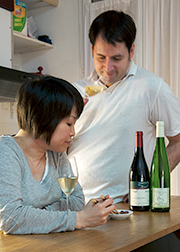“Eat your soup!”
You may have heard this phrase countless times as a child… unless you grew up in Japan that is. In the Japanese language, the verb used for the consumption of soup is nomu ( 飲む ) meaning -to drink-!
Drinking soup
Considering that soup is a liquid, I guess it’s not so shocking, but it’s also interesting to look at further implications, which are more cultural than grammatical. Generally speaking, Japanese soups are thinner than the puréed vegetable or cream soups of western cuisine. They tend to be based on either chicken broth or dashi, and you’ll usually find small pieces of tofu, seaweed, mushroom, etc. floating around. No blender required.
Soups are never served on their own before a meal, rather alongside the rest of the food, as one might expect a drink to be. In fact, Japanese soup bowls are much smaller and almost cup-shaped, and the Japanese literally drink their soup straight from the bowl. While it is considered rude in the west, you won’t find a spoon in a Japanese restaurant, and chopsticks are only used to fish for the delicious ingredients.
Soup and Wine
Most importantly is perhaps the idea that soup quenches one’s thirst. I don’t believe we have that attitude in the west, but after getting used to this in Japan, I may just as well reach for the soup bowl than the water to wash down a big bite of sushi.
For this reason, it might be a bit difficult to really conceive of soup and wine pairings. For the sake of completion however, I generally find that the hot umami-rich soups go best with a chilled full-bodied white, though a mature sweet Riesling also works quite well in certain cases. For the luxurious Dobinmushi soup however, made from the very expensive matsutake mushroom, one should definitely open a mature earthy wine, which might normally accompany truffles.
For specific pairings check out the Japanese Food & Wine Pairing Chart.






